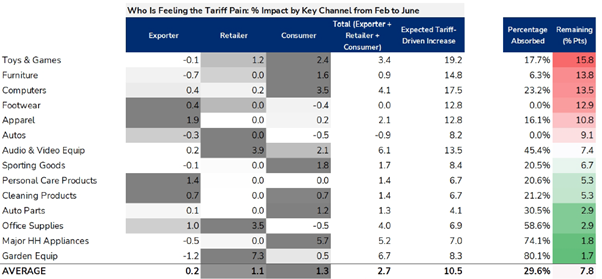Why Berkshire Hathaway is on this fundie's radar
With a long-term lens and a preference for high-conviction infrastructure assets, Sarah Shaw Chief Investment Officer at 4D Infrastructure isn’t in the business of fast turnover, but when she moves, it matters.
In this week’s Q&A, Shaw breaks down a recent rare addition to the portfolio, why Berkshire Hathaway is now on her radar, and the economic signal that’s got her most concerned.
From transcontinental rail deals to tariff shockwaves and free cash flow inflexion points, Shaw offers a high-conviction look at where she’s seeing value and where the risks are rising.

What’s your most recent investment and why?
We are infrastructure investors, so we have long-term investment horizons. As such, we don’t recycle names too often but rather undertake significant due diligence ahead of building an investment position for a long-term hold.
One of the more interesting investments recently was in January into the Australian gas pipeline operator, APA Group (ASX: APA).
We believe APA has a critical role to play in Australia’s energy mix, and it has been completely oversold on sector sentiment.
It was trading sub <$6 on entry, making it a high-quality value play underpinned by a strong yield that was too attractive to ignore.
Which investment did you add to your watchlist this week?
We have actually added a stock to our watchlist that is not in our universe or investible for 4D, namely Berkshire Hathaway (NYSE: BRK.B). Buffet owns one of North America’s top Class 1 rails, BNSF Rail.
We have recently had one portfolio company, Norfolk Southern (NSC), be the subject of a friendly merger proposal from Union Pacific (UNP), which would create a transcontinental railway from the East to the West Coast – unprecedented in the US rail industry network.
The merged company would create a AUD$300 billion behemoth critical to the functioning of the US economy and the transportation of goods and commodities to consumer, industrial, and export markets.
Berkshire, through its wholly owned BNSF, is expected to be considering a proposal for CSX (another portfolio holding) in order to protect its network and industry position. The current M&A activity is a function of President Trump’s appointment of a chairman to the rail industry regulator (the STB) that is seen to be friendly to industry consolidation for the first time this century, noting this is a sector that has only seen two deals in two decades. We continue to monitor this situation closely as we own both of the targets.
What is the most recent investment you have trimmed or sold, and what drove this decision?
We exited a position in North American pipeline operator Williams (NYSE: WMB). We fundamentally continue to rate the company and the sector very highly, but after a strong share price run, the valuation was stretched, and we saw a better risk/return opportunity elsewhere.
What’s your favourite chart or data point from this week?

Source: Wolfe
This is a great macro chart from Wolfe Research. With all the uncertainty of tariffs, and their impact on inflation and the read-through to US growth and the Fed rate outlook, a lot of economists' estimates have lacked rationale.
Wolfe have estimated the expected tariff-driven increase to various goods’ prices and then tracked how much of this has been absorbed by the economy so far. Three mechanisms are used to assess how tariffs can be absorbed, namely via the exporter reducing prices, via the retailer reducing prices (cutting their margins) and/or via the consumer (in higher prices). Overall, they believe less than a third of the estimated pass-through has been absorbed so far.
With the shock downside revisions to US non-farm payrolls last week, and the market bringing forward the tariff downside impact to US growth and additional Fed cuts, the absorption of tariffs, particularly by consumers and into CPI, is important to track.
What was your weekly high – a standout market moment or highlight?
One of our core European airport holdings, Fraport, reported Q2 results, which saw the stock up ~10% since the announcement.
While the results themselves were broadly in line with expectations, the market started to get behind our investment thematic.
We believe the company is at a FCF inflexion after a significant period of investment and Q2 saw signs of this thematic playing out with the market starting to appreciate the investment case.
What was your weekly low – a market disappointment or challenge from the week?
Non-farm payrolls in the US were significantly below expectations last Friday – so much so that Trump fired the head of the Bureau of Labor Statistics, responsible for publishing the data.
Not only were the July payrolls 73k versus the estimated 105k, but the prior two months of revisions were negative 258k.
This is the largest revision since records began in 1979, outside of COVID.
The labour market is a key barometer of the health of the US economy, and the large revisions have increased concerns of an earlier, and potentially larger, negative impact from Trump’s tariffs.
Economists have pointed to various explanations for the large revisions, the main being that those businesses that file their survey responses incorrectly or late tend to be those that are struggling to keep afloat and hence those reporting much lower payrolls.
The health of the US economy obviously has an impact on corporate fundamentals, so it must be monitored closely by us and the market.
What first drew you to markets or this sector?
I have a finance and law background and was attracted to the markets as a way of using my analytical skillset in a financial situation to determine whether stocks were over-/or undervalued.
Real assets like infrastructure appealed due to the visibility of earnings streams, which makes that analysis more reliable.
Early wins drove a love for the markets and the growth thematics drove a passion for infrastructure.
What continues to motivate and inspire you as an investor?
I think infrastructure is the most exciting investment sector of the next 30 years with defensive earnings and yield underpinning some phenomenal growth drivers and the ability to actively manage for short term cyclical events.
I’ve developed a real passion for the asset class, which I believe everyone should be able to capitalise on, and am motivated to ensure that the opportunity is understood and available to all.
How do you unwind when you’re not thinking about the market?
Out and about exploring Australia’s coastline both in and out of the water, hibernating indoors with a good book or indulging in my dual passion of travel and wine.

4 topics
3 stocks mentioned
1 contributor mentioned

